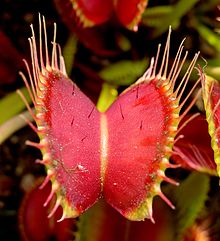
Carnivore
About this schools Wikipedia selection
SOS Children volunteers helped choose articles and made other curriculum material Click here for more information on SOS Children.

A carnivore (pron.: / ˈ k ɑr n ɪ v ɔər /) meaning 'meat eater' (Latin, carne meaning 'flesh' and vorare meaning 'to devour') is an organism that derives its energy and nutrient requirements from a diet consisting mainly or exclusively of animal tissue, whether through predation or scavenging. Animals that depend solely on animal flesh for their nutrient requirements are considered obligate carnivores while those that also consume non-animal food are considered facultative carnivores. Omnivores also consume both animal and non-animal food, and apart from the more general definition, there is no clearly defined ratio of plant to animal material that would distinguish a facultative carnivore from an omnivore. A carnivore that sits at the top of the foodchain is an apex predator.
Plants that capture and digest insects are called carnivorous plants. Similarly, fungi that capture microscopic animals are often called carnivorous fungi.
Classification
The word "carnivore" sometimes refers to the mammalian Order Carnivora, but this is somewhat misleading. While many Carnivora meet the definition of being meat eaters, not all do, and even fewer are obligate carnivores (see below). For example, most species of bears are actually omnivorous, except for the giant panda, which is almost exclusively herbivorous, and the carnivorous polar bear. In addition, there are plenty of carnivorous species that are not members of Carnivora.
Outside the animal kingdom, there are several genera containing carnivorous plants and several phyla containing carnivorous fungi. The former are predominantly insectivores, while the latter prey mostly on microscopic invertebrates, such as nematodes, amoeba and springtails.
Carnivores that eat insects and similar invertebrates primarily or exclusively are called insectivores, while those that eat fish primarily or exclusively are called piscivores. Large piscivore amphibians were the first vertebrates to conquer land, they evolved 400 million years ago. Insectivores evolved next and predators of other vertebrates after that.
Carnivores may alternatively be classified according to the percentage of meat in their diet. The diet of a hypercarnivore consists of more than 70% meat, that of a mesocarnivore 50-70%, and that of a hypocarnivore less than 30%, with the balance consisting of non-animal foods, which may include fungi, fruits, and other plant material.
Obligate carnivores
Obligate carnivores or 'true' carnivores depend on the nutrients only found in animal flesh for their survival. While they may consume small amounts of plant material, they lack the physiology required for the efficient digestion of vegetable matter and, in fact, some carnivorous mammals eat vegetation specifically as an emetic.
Some research indicates that felids including the domestic cat are obligate carnivores requiring a diet of primarily animal flesh and organs. Specifically, cats' metabolisms appear unable to synthesize certain essential nutrients (including retinol, taurine, and arachidonic acid) out of vegetable matter, and thus rely on animal protein in their diet to supply these elements. Synthetic forms of essential nutrients such as taurine in the lab have allowed feed manufacturers to formulate foods for carnivores including domestic pets and zoo animals with varying amounts of plant material.
Characteristics of carnivores
Characteristics commonly associated with carnivores include organs for capturing and disarticulating prey (teeth and claws serve these functions in many vertebrates) and status as a predator. In truth, these assumptions may be misleading, as some carnivores do not hunt and are scavengers (though most hunting carnivores will scavenge when the opportunity exists). Thus they do not have the characteristics associated with hunting carnivores. Carnivores have comparatively short digestive systems, as they are not required to break down tough cellulose found in plants. Many animals that hunt other animals evolved eyes that face forward, thus making depth perception possible. This is almost universal among mammalian predators. Other predators, like crocodiles, have sideways facing eyes and hunt by ambush rather than pursuit.
Prehistoric carnivores
The first vertebrate carnivores were fish, and then amphibians that moved on to land. Early tetrapods were large amphibious piscivores. While amphibians continued to feed on fish and later insects, reptiles began exploring two new food types, tetrapods (carnivory), and later, plants (herbivory). Carnivory was a natural transition from insectivory for medium and large tetrapods, requiring minimal adaptation (in contrast, a complex set of adaptations was necessary for feeding on highly fibrous plant materials).
Prehistoric mammals of the crown-clade Carnivoramorpha (Carnivora and Miacoidea without Creodonta), along with the early order Creodonta, and some mammals of the even earlier order Cimolesta, were true carnivores. The earliest carnivorous mammal is considered to be the Cimolestes that existed during the Late Cretaceous and Tertiary Periods in North America about 65 million years ago. Most species of Cimolestes were mouse to rat-sized, but the Late Cretaceous Cimolestes magnus reached the size of a marmot, making it one of the largest Mesozoic mammals known (20-60g). The cheek teeth combined the functions of piercing, shearing and grinding, and the molars of Palaeoryctes had extremely high and acute cusps that had little function other than piercing. The dentition of Cimolestes foreshadows the same cutting structures seen in all later carnivores. While the earlier smaller species were insectivores, the later marmot-sized Cimolestes magnus probably took larger prey and were definitely a carnivore to some degree. The cheek teeth of Hyracolestes ermineus (an ermine-like shrew - 40g) and Sarcodon pygmaeus ("pygmy flesh tooth" - 75g), were common in the latest Paleocene of Mongolia and China and occupied the small predator niche. The cheek teeth show the same characteristic notches that serve in today's carnivores to hold flesh in place to shear apart with cutting ridges.
The theropod dinosaurs such as Tyrannosaurus rex that existed during the Mesozoic Era were "obligate carnivores".


